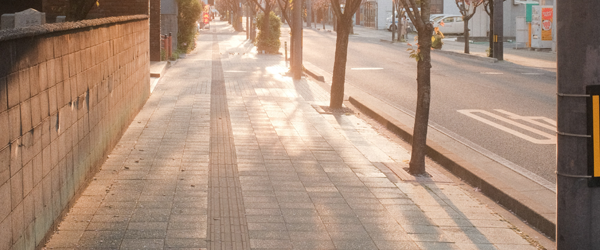
In California, someone riding a bicycle may move out of the bicycle lane when “reasonably necessary” to avoid hazardous conditions, even if they are moving slower than traffic (Cal. Veh. Code § 21208). When vehicle traffic is heavy and few pedestrians are in sight, it might be tempting to ride on the sidewalk to avoid road hazards, but as personal injury attorneys here in California, we want to share a few thoughts about riding a bike on the sidewalk. Ask yourself if it’s really safe to ride a bike on the sidewalk? Or, for that matter, if its even legal where you are?
Safety Considerations
Too often, cyclists are hit and killed by vehicles and California is in the top three states for pedestrian and cyclist fatalities due to collisions. Speed is often a contributing factor, but most fatalities from a collision involving a cyclist occur in urban areas. The reality is that many cyclists are not seen by drivers until it is too late. Riding on a sidewalk where the driver of a vehicle isn’t expecting you may mean they are not looking for you. If a car is backing out of a driveway, they might be looking for coming traffic on the road without looking for a bike coming down the sidewalk. Trucks coming in and out of alleys making deliveries are also a high-risk factor for a cyclist on a sidewalk as the buildings along the alley may block their view of you on the sidewalk. Being seen is vital for cyclists. Nearly 25% of bicyclist fatalities in California happen at intersections.
Additionally, sidewalks don’t have the same advantages of maneuverability as the roadways. Even if there’s a bike lane, a cyclist can enter the vehicle travel lane(s) as needed to avoid hazards. Trees and landscaping, uneven surfaces, benches, mailboxes, and other things take up a lot of real estate on the sidewalk, and can create unexpected obstacles with little room to avoid them.
Pedestrians also don’t anticipate faster moving bicycles or scooters and combined with the limited space a sidewalk provides can lead to devastating collisions with those on foot.
Legal Considerations
Local governments in California are allowed to make their own regulations when it comes to the use of bikes, skates, and scooters on sidewalks. For example, in San Francisco, children under the age of 13 may ride a bike on the sidewalk (unless otherwise posted) per the San Francisco Transportation Code, Section 1007. In San Luis Obispo, California, the Municipal Code Section 10.72.100 restricts all people from riding a bike on the sidewalk. However, the City of San Luis Obispo has re-opened discussions within the Active Transportation Committee on allowing bikes to ride on the sidewalk, believing ticketing cyclists for riding on the sidewalk to be a deterrent from riding as a way of commuting. San Luis Obispo has set a goal of raising the share of commuter trips by bike to 20% by the year 2030 and is actively implementing new safety measures and bike lanes for that purpose. San Francisco is also working diligently to make the streets safer for cyclists. As a result, it would be best to keep an eye on the regulations and policies in these and other cities in California for the legal implications of riding a bike on the sidewalk.
Children Riding Bikes on the Sidewalk
Many children learn to ride a bike on two wheels in a driveway or residential area with minimal vehicle traffic. They will also likely have parental/guardian supervision while learning to balance and pedal. As children become more comfortable riding on their own, they may be hesitant to ride in the street, which is understandable as cars are much bigger and faster than a child on a bike. In some areas in California, like San Francisco, it may be legal for a child to ride their bike on the sidewalk, but the same safety considerations that we outlined above apply to children, too. Even in a residential area, there will be cars going in and out of driveways. Parked cars, trees, and other objects may limit the visibility of the sidewalk to a driver as they navigate a driveway and children can be even harder to see as they are not as tall on a bicycle as an adult. And keep in mind, most fatal collisions with a bicycle happen between 6:00 and 9:00 PM, which may be when people are returning home from work and children may be out riding in their neighborhood. Children may also be tempted to use the sidewalk when the commute on a bike going to and from school as they may think the route is safer or more familiar, but they will then face the same challenges as an adult riding a bike on the sidewalk with limited maneuverability, reduced visibility at intersections, and increased hazards.
Sadly, children under 14 make up 37% of all fatal bicycle collisions each year and one of the hardest things we ever have to do as bicycle accident attorneys is represent the family of a child who lost their life while riding a bike.
Be sure to talk to your children about the safety considerations of where they ride, even if it is legal in your area for them to use the sidewalk on a bike.
If you or a loved one has been injured while riding a bike, contact us today for a free consultation.

